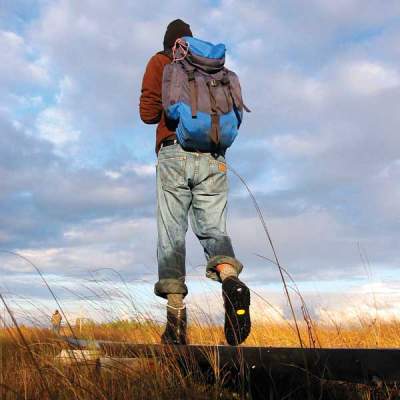When the first commercial train arrived in Lhasa in July 2006, it set a number of records. It set a record for the highest railway on earth, eclipsing the Peruvian Railway of the Andes by over two hundred metres. The railway through Tibet is likely the most expensive ever constructed, costing over US$4.2 billion to lay 1,140 kilometres of track. Almost half of that track runs over permafrost terrain ¬– another world first. And for a number of reasons—environmental, demographic—the line holds a more dubious honour. It is the world's most controversial railway.
Chinese news sources all praise the railway project—the sacrifice that Chinese workers endured in building the line from Golmud, in central China, to Lhasa, and the engineering of more than 400 bridges and 30 kilometres of tunnels. The railway is a source of great national pride, on par with China's second manned space flight.
But not all Tibetans see the railway as an engineering marvel. Some Tibetans in Lhasa are fearful of the changes that will take place in the wake of the new railway. You only have to go to the town of Bayi, east of Lhasa, to see what they mean. Bayi has very little Tibetan presence: it's a fully-fledged Chinese town, crowded with white-tiled buildings, karaoke halls and mini-brothels catering to Chinese army garrisons. Bayi means "8-1" in Chinese (commemorating August 1, 1927, founding date of the People’s Liberation Army), but Tibetans joke that it means eight Chinese for every one Tibetan.
Speaking on condition of anonymity, a Tibetan in Lhasa projected that Lhasa residents will be the first to be hit by the changes expected in the wake of the new rail line. The Chinese are quite open, he said, about their plans to bring in Chinese settlers from impoverished regions of China. He worries that this projected influx of cheap Chinese labour will cause unemployment for Tibetans by usurping Tibetan jobs, even in industries that have been traditionally Tibetan-dominated such as furniture painting, or house painting. In the meantime, he says, prices have already risen in Lhasa due to increased demand. “Rural Tibetans think of the railway a novelty—they are curious about seeing it. But many educated Tibetans are very scared. They know it is not about tourism. It’s about mining and taking out Tibet’s resources. It’s about bringing many more Chinese settlers in.”
Official estimates put the number of Han Chinese residents in Lhasa at 100,000 out of a total population of 409,500, but observers estimate that more than half of Lhasa's population is Han Chinese, according to the US State Department’s 2004 report on Tibet.
With the large influx of Chinese settlers—particularly in urban areas like Lhasa—some Tibetans fear they will become marginalized in their own country. And human rights organizations have come to their defence. According to The Geneva Convention, a power is prohibited from deporting or transferring its own civilians to a country it is occupying—and some human rights organizations argue that China's policy of offering higher salaries and tax breaks to encourage Chinese settlers in Tibet constitutes a violation of that convention.
The new railway will likely boost the number of Chinese tourists flocking to Tibet as well. Tibet is viewed as an exotic colonial destination, a far-flung corner of the Chinese realm, and presently sees upward of a million Chinese tourists every year. That number could potentially soar with the promised comfort and speed of the train. The summer of 2006 saw record numbers of Chinese tourists coming into Lhasa.
There are some peculiar obstacles to overcome along the Golmud-to-Lhasa track. Chief among these is sudden ascent to altitude, which can cause passengers to reach for the sick bags—or turn blue. Most of the track within Tibet is above an altitude of 4000 metres; along the route is Tanggula Shan station which, at 5070 metres, is the highest in the world.
The solution to the altitude problem is to pressurise the railcars, rather like jetliners. This requires high-tech tinkering. Enter the US company General Electric Transportation, which is supplying all the locomotives for the project. Three Canadian companies—Bombardier, Power Corporation and Nortel—are heavily involved. Montreal-based Bombardier is supplying 361 railcars for the venture, while Nortel Networks supplies the digital wireless communications network for the project.
The involvement of the Canadian companies has raised the hackles of human rights activists and exiled Tibetans living in Canada. A campaign has been launched by several activist groups, calling on the companies to withdraw from the railway project.
A second major obstacle is that of dealing with the permafrost. Over 550 kilometres of track has been constructed over the fragile terrain—and a project of this scale over permafrost has not been attempted elsewhere. The line depends on underground coolants to stop the permafrost from melting. But despite these efforts, sections of the Golmud-Lhasa railway have become unstable because foundations are sinking into the softening permafrost soil. Damage to concrete pillars and bridges is compounded by shifting sand dunes, which are encroaching on the tracks.
The railway also poses an issue for migrating animals, like the highly endangered Tibetan antelope. Sections of the line are elevated, with fencing in place to stop animals wandering onto the tracks. To get past the barrier, engineers have thoughtfully built culverts for animals to pass under the tracks. But while yaks can certainly be coaxed through such culverts by herders, wild animals might not be so easily persuaded.
Despite predictions by environmentalists and human-rights activists, the Golmud-Lhasa railway has been running for a few short months. And some Tibetans—including the exiled Dalai Lama—are hopeful that, ultimately, it will bring economic growth to the country. “The railway line itself is not a cause of concern for the Tibetan people,” the Dalai Lama said through his spokesman. “How it will be used is the main concern.”
To read more about Tibetan protest against the railway, please click here.
Michael Buckley has travelled widely in Tibet, the Himalayas and Central Asia. He is author of Heartlands: Travels in the Tibetan World (UK, 2002) and Tibet: the Bradt Travel Guide (UK, 2006). The guidebook is supported by a website:www.himmies.com.
Add this article to your reading list



